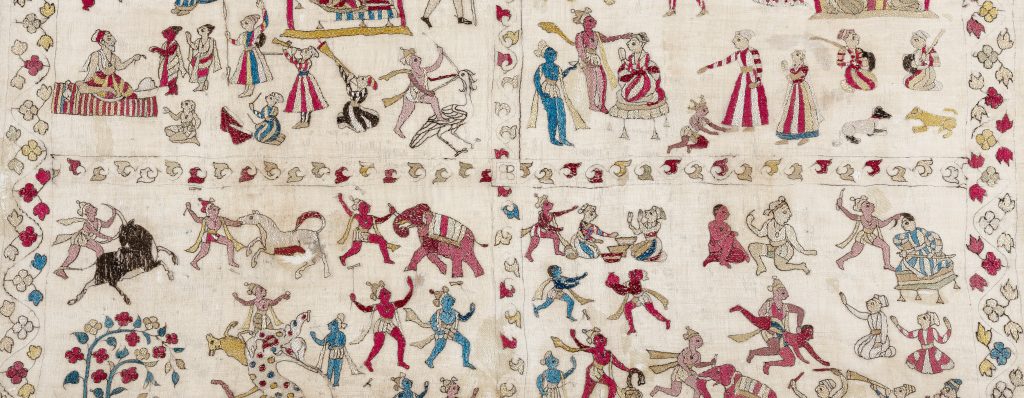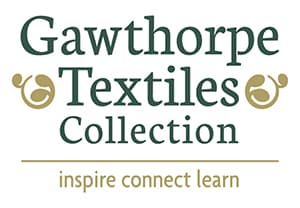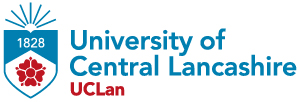Global Threads: African Fashion
4



This exhibition shares student work using African textiles from Gawthorpe Textiles Collection to inspire new fashions. First Year Fashion Design students from UCLan visited Gawthorpe to study fabrics in the collection originating from Africa, or that were produced in the UK for the African export market. Their aim was to study authentic African textiles and explore how traditional African techniques and garment silhouettes can influence and inform their own creative outputs.
By studying the textiles up close students were able to see first hand examples of printing, dyeing and weaving using traditional techniques from across the African continent such as adire indigo resist dyeing from Nigeria and kente weaving Ghana. The export fabrics showed the lengths that manufacturers went to in an effort to closely imitate the traditional hand made techniques, even when the fabrics were being machine made and mass produced on an industrial scale.
Each of the students then took inspiration from the traditional techniques, motifs and colours applied to the textiles and recreated them for the “Global Threads” project to produce designs, samples and a fashion forward final garment. Browse the student’s work, design process and the original textiles that inspired them below.
“For my project I really wanted to present traditional African textiles in a contemporary and modern style that would still celebrate them. The textiles I viewed at Gawthorpe Hall were hugely inspiring, to understand the craftsmanship that went into the traditional pieces and then to clearly see how the styles had been interpreted using more modern manufacture techniques. This played a huge part in my final piece as I interpreted motifs found on the textiles as embroidery, which then became the basis of the print used for my garment. I still wanted the piece to feel quite artisan and so I used a hand embroidery technique for my collar design, to celebrate the traditional craftsmanship of the textiles.”
Abbie Jarvis
This batik style printed textile from Gawthorpe Textiles Collection was selected by Abbie as a source of inspiration. The floral elements of this print were re-imagined in the embroidered collar on the final dress.
The stylisation of the birds and repeating triangular border on this textile show a strong South East Asian influence on the design and similarities can be observed between this print and the traditional batik sarongs from Indonesia and Malaysia. This textile was printed in Lancashire for the export market.
In this digital page Abbie shows some of the inspiration that went into the design.
This digital page details the work that went into creating the fabric used in the final garment.
This digital page shows the creation of the embroidered collar.
“The inspiration behind this dress pays homage to the cultural heritage of Africa. The paisley patterns on the sleeves can be traced back to indigenous African textiles, which have a long and rich history of vibrant colours and intricate patterns. At Gawthorpe Hall, Batik and paisley textiles were a major source of inspiration for me. The sleeves were inspired by the rolled sleeves of an agbada, a traditional African robe. This was used as a pattern-cutting piece alongside the textiles to create a contemporary look. The main green colour and different hues used were chosen from the African flag – a common recurring theme with British and African flags in the textiles at Gawthorpe hall. The plain green mixed with the paisley pattern, which is a fusion of both Persian and Indian design elements, have long been associated with opulence, and now have become a part of African fashion. By incorporating these traditional design elements, I have tried to create a collection of ingenuity through this dress. ”
Aisha Irfan
This is one of the Lancashire produced printed cottons from the Gawthorpe Textiles Collection. It was produced for the global export market and blends elements of Indian and Persian design for the print. Although this is machine printed, the design is intended to imitate hand painted and block printed textiles. Aisha used the paisley motifs as inspiration for the hand painted fabric used in the sleeves of the final dress, bringing this design full circle back to its hand crafted origins.
This digital page shows some of the sources of inspiration for Aisha’s final garment.
A digital moodboard created by Abbie Jarvis
This digital page shows some additional details of the boldly patterned, hand painted fabric created by Aisha for the sleeves.
“I really enjoyed having the opportunity to view the collection of African textiles at Gawthorpe Hall. I found it really inspiring to gain an insight and an understanding about different cultural practices within different countries’ textiles practices. One of the most inspiring elements of the samples on display were their bold use of colour and pattern which upon researching, I found to have much cultural and symbolic significance. “
Amy Brown
This hand woven kente cloth from the Gawthorpe Textiles Collection formed part of the inspiration behind Amy’s design. The vibrant, geometric patterns were re-created as a scaled up band that draped like a sash across the finished dress.
Kente cloths get their distinctive geometric patterns arranged in stripes from the small, portable looms that they are woven on. The long, narrow strips of cloth are then sewn together to create wider textiles that can be turned into garments.
This digital page showcases some of the inspirations behind Amy’s final design.
This digital page explains some of the process of developing the patchwork fabric for the dress.
In this digital page, we see the complex patchwork process required to create the fabric.
“For this project, I was tasked with creating an A-line dress with clear inspirations from the African textiles I viewed at Gawthorpe Hall. I heavily took inspiration from the shapes and motifs that were created on the textiles. I found the textiles really inspiring because most of the techniques used to create the finished pieces were done by hand. I really liked this idea of creating gorgeous textiles by hand that I took through into making my final design. I created a batik sample with a small amount of machine embroidery and a crochet circle which I later developed to create my own fabric yarn. Apart from making the dress and adding the embellishments, I created everything else with my hands to link back to the African textiles from Gawthrope Hall.”
Felicity Heavyside
This is one of the textiles from Gawthorpe Textiles Collection that Felicity used as inspiration. The background pattern of this printed textile for the export market was re-interpreted in textural crochet embellishments.
The design of this fabric is another piece that displays the incorporation of South East Asian batik wax resist elements, showing the wide range of influences that created the style we now associate with African ‘Wax Prints’.
In this digital page we can see some of the inspiration that Felicity used, including the imitation batik textile above.
On this digital page Felicity details the process of developing mock ups using small scale mannequins allowing ideas to be tested out without having to waste time and materials on larger scale versions.
“The aim of my project was to take inspiration from African textiles as sensitively as I could, so I spent a lot of time looking into the original techniques and history and considered how I could recreate the effects with the materials I had at my disposal. I really enjoyed the variety of textiles at Gawthorpe Hall, particularly the Kente samples, as I have read about the technique but never had the chance to see it in person. I also took inspiration from the original labels attached to the textiles and incorporated a lot of the words into my samples and final design.”
Naomi Robinson
One of Naomi’s inspirations was this piece of adire indigo resist tie and dye from Nigeria, now part of the Gawthorpe Textiles Collection. On this piece Naomi was able to identify two distinct methods – alabere, where stitching is used to create a feathered stripe effect and oniko, where small seeds are tied into the fabric before dyeing which create the tiny rings forming a spot motif.
This process sample shows the method used in oniko adire resist dyeing. Small round seeds have been tightly tied in place using a waxy grass which helped to block the string indigo dye from penetrating the fabric. Once dyed the seeds would be untied and removed creating a textile patterned like the example shown above.
This digital page shows Namoi’s notes on the adire sample seen on the visit to Gawthorpe Textile Collection.
This unusual textile was another piece that Naomi highlighted as part of the inspiration for the final garment. It is an example of resist dyeing using cassava starch applied through a stencil, the cassava starch is then dried in the sun and blocks dye from accessing the fabric underneath it. This technique was widespread in Nigeria and surrounding areas but what makes this textile more unusual is the design itself. Although depicted in a style that would be familiar to the local population, the figures in this image are actually those of King George V and Queen Mary of Great Britain. Their likeness is probably copied from an ‘official’ portrait but re-imagined in a local artists own preferred style.
This sample shows part of the process used to create the textile shown above. On this piece a cassava starch paste has been stencilled on but the fabric has not been dyed yet. One of the preferred materials for creating the stencils used in this process were the thin sheets of zinc metal that were used to line chests for transporting tea. When the chests were no longer used for tea the zinc would be stripped out and re-used by cutting into stencils.
In this digital page we see more of the inspiration that went into Naomi’s design.
This digital page shows the development of samples based on the cassava resist dyeing seen at Gawthorpe.
“The Global Threads project opened my perspective towards African Fashion. I got to learn the importance of culture and heritage when it comes to inspiration for fashion. I got to experiment with traditional methods, such as using starch and stencils to create a repeated pattern; this was inspired by the procedures used within the original textiles I was fortunate to observe at Gawthorpe. This visit allowed me to appreciate the ways textiles are created in another country. These techniques inspired my final design.”
Yolanda Cookson-Sanz
This textile from Gawthorpe Textiles Collection was used as inspiration by several of the students, including Yolanda.
Although machine printed, the circular motifs on this fabric imitate a traditional hand tie-dye technique. There are examples of both the handmade and machine made versions of this pattern in the collection at Gawthorpe. Many of the traditional versions were donated by companies who manufactured African style prints in the UK, indicating that their designers often worked from authentic African-made textiles when creating their versions.
In this digital page Yolanda shows some of the inspiration sources that shaped the finished garment.
This digital page shows the process of sampling different combinations of colour and texture on small scale mannequins and also includes Yolanda’s notes on which combinations were preferred.
Related

Siri, stop the patriarchy
A digital zine by artist Emily Simpson looking at feminism, gender equality, our rights to protest and what feminism means to the artist as a non-binary person.
View item
Re:Fashion Challenge 2023
The Re: Fashion challenge aims to teach young people the skills needed to make and adapt clothes in an effort to tackle fast fashion and embrace a more conscious and sustainable approach to garment production.
View item
Chamba Rumals
A partnership between Gawthorpe Textiles Collection and Dr Rohini Arora to give an in depth look at two rare and precious examples of embroidery from the Chamba region of India.
View item
Skilled, Responsible & Hardworking
Academic research by Gill Crawshaw focusing on the stories of Lancashire's disabled cotton workers.
View item




































Comments
(2 comments)
Fadheela
Great work everyone!! It all looks amazing!
Amanda
Amazing work, so inspiring and unique outcomes inspired by this unique textile archive!
Leave a comment
You must be logged in to post a comment.